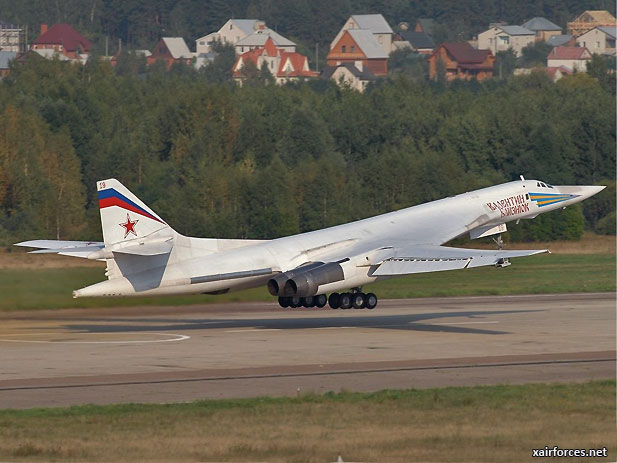
PM Medvedev approves new bomber for Russian Air Force

Russia is going to build a brand-new strategic bomber, Russian Prime Minister Dmitry Medvedev has said at a Kazan meeting on strategic aviation. It will be developed alongside the fifth-generation fighter. Medvedev stressed it wasn’t enough to maintain and revamp the existing strategic bombers.
In the next decade Russia’s Air Force is expected to get a new long-range bomber. However, some experts are calling into question the necessity of such an aircraft because they believe that the modern air defence and missile defence systems could make it redundant. Nevertheless, we believe that there is a place for a new aircraft of this type.
At present, Russia’s Air Force is using three types of bombers in long-range aviation: the Tu-22M3 long-range supersonic bomber, the Tu-95 heavy bomber and the Tu-160 supersonic heavy bomber. The operational range of the Tu-22M3 depends on its payload and could range from 1,500 to 3,500 kilometers. The other two aircraft can cover the distance of up to 6-7 thousand kilometers without refueling, which means that when equipped with long-range cruise missiles, they can hit targets in North America.
The average age of the Russian bomber is less than that of American aircraft. Like its Russian counterpart the Tu-95, the backbone American bomber B-52 made its maiden flight in 1952. The B-52H aircraft which are currently being used by the U.S. Air Force were built between 1960 and 1962. The B-1B aircraft built in 1984-1988 and the B-2 built in 1989-1997, are about the same age as their current Russian counterparts.
The B-52, the “youngest” of which is 50 years old, is expected to remain in service until 2040. It is expected that these bombers will be replaced between 2025 and 2040 with the new generation aircraft which are being developed as part of the NGB (New Generation Bomber) programme.
The new plane should also replace the B-1B, which the decommissioning is expected to start in 2030, and will be used alongside the B-2, which is expected to remain in service until the end of the 2040s or even longer.
Judging by what is known about technical features of the new generation bomber, it will differ from the B-2 in terms of its takeoff weight (about 100 tons as opposed to 170), bomb load (13 tons as opposed to 23) and operational range (up to 3,800 kilometers as opposed to the current 5.000). Changing some of the new craft’s technical characteristics should help reduce the cost of production of the new aircraft and consequently, the price of an individual plane will be reduced to 500-600 million dollars compared to the price of the B-2 bomber, which currently stands at more than a billion dollars.
Russia is watching closely the implementation of the NGB programme. Based on the last known information, the concept of a “medium-heavy” bomber boasting an operational range which would be longer than Tu-22 M’s but shorter than that of Tu-160 is considered rather to be attractive.
However, in order to answer the question about the potential of the new aircraft, which is being developed as part of the long range aircraft project, one has to understand and the objectives it is expected to meet. It appears that this Russian long range bomber should be able to hit targets in Eurasia without having to use airborne refueling and with air fuelling it should fulfill intercontinental range tasks. This means its operating range should be around 3,500 kilometers with full payload and between 5,000 and 5,500 kilometers with a reduced payload.
The cost of their production can be reduced through a number of measures like for example through unifying the manufacturing of its engines with the T-50 fighter jet. For one, experts are discussing the possibility of those of building a 100 or 120-ton bomber equipped with four Al-41 engines (T-50 for example, has two such engines) and the development of avionics for the new bomber based on the equipment designed for the T-50. This should reduce the cost of development and exploitation of the new aircraft.
As an alternative, some experts suggest using the existing and advanced tactical fighter jets of the Su family, Su-27, Su-30 and T-50 and Su-34 bomber as well as upgrading the existing long range bombers.
Although the first option is attractive from the financial point of view, unfortunately it doesn’t always assure the necessary capabilities in the event of a war. It reduces the capabilities of tactical bombers to hit targets beyond their operational rage (up to 1,500-2,000 kilometers).
The second option is better but has a time limit. Although the modern aircraft can remain in service for a long time, they have a shelf life. It takes a long time to design and manufacture new aircraft. If Russia stops working on developing a new bomber, it risks having no long range bombers at all by 2040-2050. If in the meantime, new technology emerges that will enable it to do without a traditional heavy bomber, the work on its development can be suspended but only after a new viable alternative is found.
Source: Moscow / RIA Novosti / June 10, 2012
Photo: Russian Air Force Tu-160 Blackjack Supersonic Heavy Bomber (Photo by media.aknet.kg)
(9.06.2012)
|